Abstract
In 1964 the American Institute of Architects (AIA) launched a competition to redevelop its headquarters at the Octagon Building (1801) in Washington, DC. The Kennedy Administration had recently reset the direction of Federal architecture and committed to new legislation to protect the historic environment. But while the government embraced architectural modernism in this period there was uncertainty about how architects should relate new buildings to existing cities. This paper examines the competition-winning entry by Mitchell/Giurgola and the design review process that unfolded in its wake. Doing so reveals competing aspirations for the site and professional disagreement about how new and old buildings should be related in such situations. The paper argues, however, that forces beyond architecture, notably urban land value and the responsibilities of the profession to its members, crucially shaped the outcome, depriving Washington, DC of an exemplar for how contemporary architecture could engage with valued existing buildings.
Introduction
In 1962 the American Institute of Architects (AIA) convention authorised a competition to design a new home for the organisation. Having outgrown its Washington, DC, headquarters at the John Tayloe III House, widely known as the Octagon, but wanting to stay in that location, the Institute’s competition brief called for 71,000 square feet (6,600 square metres) of new space on the site, enough for 83 staff members, and be inclusive of a board room, three conference rooms, a library, car parking and exhibition space. It also asked entrants to respect the Octagon and “the space occupied by the immediate gardens.”Footnote1 Entries were received in 1964 and the winning scheme was presented to Institute members in the January 1965 issue of the AIA Journal. Announcing the Philadelphia firm Mitchell/Giurgola as the winners, the AIA noted the competition’s call for “a building of special architectural significance, establishing a symbol of the creative genius of our time, yet complementing, protecting and preserving a cherished symbol of another time, the historic Octagon House.”Footnote2 The announcement likewise highlighted the success of the Mitchell/Giurgola design in blending “contemporary architecture with the Georgian style of the historic Octagon House on the same site.”Footnote3
The competition marks an important moment for twentieth-century architecture in the United States, highlighting the willingness of the architectural profession to demonstrate leadership in retaining and reusing historic buildings amid rapid urban redevelopment, while also not resiling from the aesthetics and underlying principles that drove modern architecture. The AIA was not dragged kicking and screaming to the cause of preservation by an angry public or restrictive legislation. That phase of redevelopment politics would come later in Washington, in the 1970s and beyond. At the time of the AIA competition the profession still assumed leadership in guiding decisions about how cities should be renewed and redeveloped as well as primacy in judging which buildings were worthy of preservation.Footnote4 The creation of a new headquarters was to be a demonstration of that foresight and capacity.
Mitchell/Giurgola’s competition winning design provided proof of concept for the aspirations contained in the AIA competition brief (). It promised to be a place of special significance, carefully attending to the qualities of the existing buildings on the site and in a way that was unambiguously contemporary. But the aftermath of the competition and the eventual withdrawal by Mitchell/Giurgola, and their replacement by The Architects Collaborative (TAC), also underlined the competing forces that acted on the Institute. Those forces were defined in part by what was possible on that site at that time, and the evident need to balance the exigencies of the present with the historical legacy and architectural character of the past. That is, the design review process highlighted ongoing contestation and perhaps generational conflict about what to do in such a situation, involving a collision of urban scales conceptualised as historical and contemporary.
Figure 1. Mitchell/Giurgola Architects, AIA Headquarters, Washington, DC, Competition Project. Photograph of the winning competition entry model. The Octagon House is in the foreground of the corner site with 18th Street to the left and New York Avenue on the right. The proposed additions are in the background. Source: Mitchell/Giurgola Collections, The Architectural Archives, University of Pennsylvania (collection 267), Philadelphia. Photograph by Rollin La France.
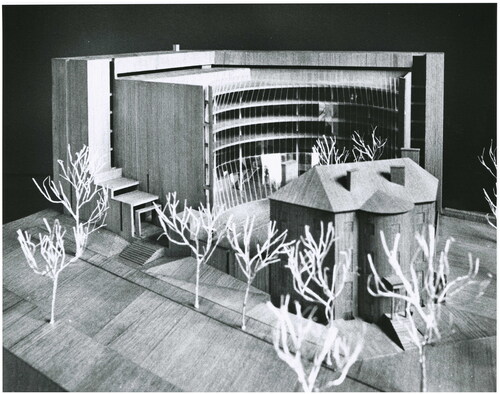
But it was not simply a conflict about how to approach what we usually now call infill development or how to manage formal or stylistic differences that undermined the result of the AIA’s design competition. The additional, more profound tension was between the Institute’s aspiration to create a lasting building of architectural merit, and its interests as an asset owner. In addition to representing the profession of architecture and therefore invested in the value of good design, the Institute was also a landowner in central DC with an associated set of financial risks and responsibilities. In the end, it was arguably the financial negotiations required to create a new headquarters that undermined the Institute’s initial enthusiasm for the Mitchell/Giurgola scheme and the wider sense of amity between new and old buildings that it promised to represent.
The paper relies on a rich trove of Mitchell/Giurgola drawings, primarily the work of Romaldo (Aldo) Giurgola, held by the Architectural Archives of the University of Pennsylvania, to reveal in detail the concerns that motivated Giurgola’s design.Footnote5 Although the project was submitted under the collective practice name, in this paper we attribute its substantive authorship to Romaldo Giurgola. Some of the perspective drawings are personally signed by him; however, our attribution is also based on his public advocacy for the project and his defence of it before the Commission of Fine Arts. The paper also draws on the minutes of the Commission of Fine Arts (CFA) meetings that document the design review process, the collections of the AIA, especially the competition brief document, and a substantial body of critical commentary from the period that appeared mostly in the architecture press. While the episode is well documented and was much discussed in the decade between 1963 and 1973, the scholarly coverage of this ambitious effort to represent the profession architecturally is relatively sparse. Apart from a very sympathetic account by Giurgola’s former colleague Jaimini Mehta, highlighting Giurgola’s deep concern with the existing conditions of a place, and Nicholas Adams’ brief coverage of the episode in in his architectural biography of Gordon Bunshaft, there are few references to the project.Footnote6 This reflects the relative dearth of scholarship on Mitchell/Giurgola generally.Footnote7 It is also evident that there is not yet a field-shaping study of efforts in this period to relate new buildings to the old. There has been a slew of recent publications focused on adaptive reuse, but, with the exception of a special issue of the journal Change Over Time, and a growing body of scholarship on the Italian architect, preservationist and theorist Gustavo Giovannoni, there have been very few historically informed scholarly articles or chapters that consider how twentieth century architects dealt with the question of new and old.Footnote8
Background
Before looking in detail at Mitchell/Giurgola’s competition-winning design, it is important to understand the forces that were shaping the context of the AIA project in the mid-1960s. Three stand out: federal policy on architecture and preservation; urban development in Washington, DC; and the architectural and urban context in the immediate vicinity of the Octagon.
In the early 1960s, the federal government’s attitude to architecture and cities evolved quickly under the influence of the Kennedy Administration. This change was represented most obviously by the newly established Guiding Principles for Federal Architecture (1962).Footnote9 Written by Daniel Patrick Moynihan, the Guiding Principles underscored the value of architectural design for the work of government in the widest sense, including its visible presence and its practical amenity. The Principles also counselled against the adoption of an official style for federal buildings, arguing instead for an engagement with the existing character of the places in which they were built, including meaningful consideration of landscape.
The cultural thrust of the Guiding Principles was supported by new government energy and resources dedicated to preservation in the period. In 1964 in Washington, DC, the National Capital Planning Commission (NCPC) established a Joint Committee on Landmarks (JCL), the city’s first locally oriented landmarks commission. The JCL created a list of landmarks and places which included the Octagon as a Category 1 landmark. The US government also put greater emphasis on statutory preservation protections during this time creating the Historic Preservation Act (1966), a piece of legislation set in train by the Kennedy Administration which prescribed an administrative structure for preservation nationally and compelled the Federal Government to protect culturally significant buildings and other resources.Footnote10 Taken together, the Guiding Principles, the JCL and the Preservation Act signalled an emergent orthodoxy with respect to the question of architectural historicity, whereby each phase of architectural development is understood as possessing its own distinct and authentic qualities and character. None of these, however, prescribed an attitude towards relating new to old.Footnote11
This new direction for federal architecture and the expanded mission for preservation had significant implications in Washington, where various iterations of the classical language of architecture were deployed right up until the 1960s as a way of depicting institutional authority and tradition. Sometimes at the expense of existing, historically significant buildings, this preference was most certainly to the detriment of contemporary architecture in the capital. From 1900 right up until the 1960s the federal government supported a broadly traditionalist approach to architectural and urban development, and an idea that federal architecture should be distinguished not by its quality and variety so much as its government-branded classicism. The new policies asserted instead the cultural value of contemporary architecture and of existing historic buildings of various periods and styles.Footnote12
In the same period a proposal for Lafayette Square, immediately in front of the White House, reflected the new architectural priorities of the government at the time. Championed by John and Jacqueline Kennedy, and designed by John Carl Warnecke, who acted as a juror for the AIA competition, the project fused a new program—a court building and offices—to the existing residential pattern of the square. In doing so it prefigured the concerns articulated in the AIA brief, and perhaps also informed it (). In 1962 the Washington Post welcomed Warnecke’s scheme, warmly praising its “preservation of a charming enclave of greenery … in the heart of the city.”Footnote13 That language was echoed by the AIA competition book, which urged due consideration for the space around the Octagon, and noted that “its delightful garden is cherished by architects and the community.”Footnote14
Figure 2. John Carl Warnecke and Jacqeline Kennedy consider Warnecke’s scheme for Lafayette Square. Source: John F. Kennedy Presidential Library and Museum, Boston, MA, KN-24273.
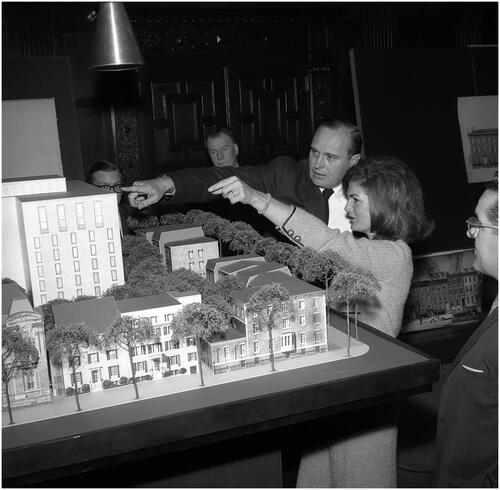
The second significant consideration for understanding the AIA design competition was the pattern of downtown redevelopment underway in Washington, DC, in the period. Private and federal-government-driven development largely ignored the traditional downtown blocks in the post-war decades and focused instead on the areas north and west of the White House. Commercial development was moving inexorably towards Dupont Circle via Massachusetts and Connecticut Avenues and along Pennsylvania Avenue and K Street into what used to be known as the West End (). New government office space and other institutional accommodation was clustered to the west and southwest of the White House. This meant that the Octagon was in a somewhat transitional zone between a leafy, mature residential environment, and an emerging pattern of commercial, educational and governmental development that extended Washington’s old downtown to the west. It is important to note that this pattern of growth and redevelopment, especially the commercial buildings developed along Connecticut Avenue, K Street and the surrounding blocks, was driven in significant part by the expansion of industry associations, professional bodies and think tanks, many of which set up shop in DC or expanded their government-influencing efforts in the post-war decades. A few blocks to the north of the Octagon, the National Association of Homebuilders, one of the largest trade groups, built a substantial new headquarters in the mid-1950s; not far from that, on Massachusetts Avenue, near Dupont Circle, the Brookings Institute established its first headquarters in the early 60s.Footnote15
Figure 3. Pattern of redevelopment underway in Washington, DC in the post-war period. Map included in Carl Feiss, “A Program for Landmarks Conservation in the District of Columbia: Recommendations to the National Capital Planning Commission on the Preservation of Historic Landmarks, Buildings, Monuments, Places and Districts of Historic, Architectural and Landscape Merit in Washington, DC” (Washington, DC: 1963). Source: Gelman Special Collections, George Washington University, Washington, DC.
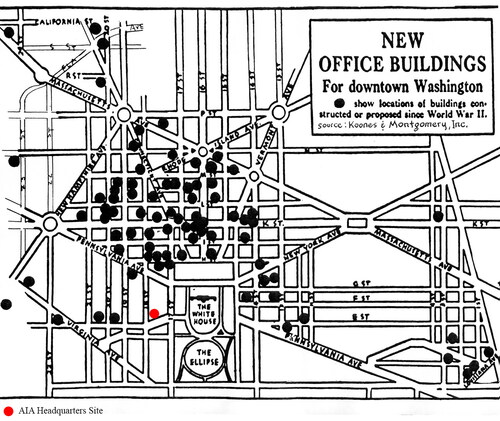
The American Institute of Architects, therefore, was not just a professionally representative body attempting to showcase leadership in design quality and stewardship of historic buildings. Like other professional associations, labour organisations, and advocacy groups, the AIA was in DC to influence government policy and represent the interests of its members. Collectively, such organisations became a bigger presence in Washington in the 1950s and 1960s, exponentially expanding their footprint in the national capital, mirroring the rapid expansion of the government itself. In the following decades, a growing army of lawyers and lobbyists set up shop in the quickly growing new office district, further driving speculative office development and continuing this pattern of physical change.
What did this mean for the area in the vicinity of the Octagon? Joseph Passoneau’s mapping of Washington provides detailed insights into the changing morphological and land use patterns in the area which allows us to picture the environs of the Octagon in some detail prior to, and in the period of, the AIA design competition. In earlier decades, around 1900, the White House and the Tayloe House occupied what was largely a residential neighbourhood composed of houses, with one or two very notable exceptions, most prominent among them being the great State War and Navy Building—later the Eisenhower Executive Office Building. By World War Two, however, this had changed notably; two wars and the accompanying influx of people to the US capital changed the city dramatically. While several blocks of row houses remained, by the start of the 1950s the area to the west of the AIA headquarters also contained substantial federal office buildings, most notably the two buildings for the Department of the Interior constructed in 1917 and 1936 respectively. In the interwar decades the NCPC viewed these dual expansive stripped classical buildings as part of the so-called Northwest Rectangle, an area of federal development imagined as a counterweight to the Federal Triangle. Both Department of the Interior buildings, one of which was later occupied by the General Services Administration (GSA), presented highly rationalised six- to eight-storey elevations to the street, and spanned entire city blocks.Footnote16
Visitors to the Octagon in the post-war period would have looked out on these federal office buildings as they descended the flight of steps at the front of the building. (Giurgola would later note that the GSA was closer to the Octagon than his proposed design for the AIA headquarters behind it.) Between the two federal office buildings a small park and plaza, which remain today, provided some relief from the “government beehives.” If those visitors had turned to their left as they exited the Octagon, they would have seen the north elevations of the Corcoran Gallery by Ernest Flagg (1897) and a set of small-scale residential and commercial buildings that were variously used as office space, residences, or hotel accommodation during the middle decades of the twentieth century. Behind the Octagon was an expansive, established garden and beyond that a set of somewhat nondescript early twentieth century buildings. If one turned to the right and looked up 18th Street there was a run of three- and four-storey, characteristic Washington rowhouses. But as the copiously illustrated competition brief made clear, these were scheduled for demolition, to be replaced by another office building.Footnote17
The scene, therefore, that Giurgola and other competition entrants would have observed in 1964 was hybrid and in transition. It contained the fabric and memory of Washington from its earliest years in the form of the Octagon itself; a characteristic but architecturally undistinguished set of red brick buildings that coloured the residential zones of Washington in the nineteenth and early twentieth centuries; and wide public spaces in the form of streets, sidewalks and central medians that included a generous tree cover. But equally, the area was home to a growing number of office buildings which meant that most properties in the area were under some pressure to intensify their use of land. Buildings in the neighbourhood were growing in height and bulk during this time. And with that came a change in the financial parameters involved in developing the land. Such changes were not only a driver for the AIA competition brief, and a challenge for the entrants, they were ultimately a source of internal tensions and confusion for the Institute itself over how intensively to redevelop its property.
The Giurgola Design
Announcing the winners of the AIA competition, jury chairman and architect Hugh Stubbins said of the design: “Mitchell and Giurgola have offered a unique approach to a difficult and unusual problem. … Most important, perhaps, is that the concept fulfils the stated requirement of demonstrating that a distinctive contemporary building can live in harmony with fine architecture of a former time” ().Footnote18 The successful Mitchell/Giurgola scheme consisted primarily of a new, five-storey building plus penthouse and basement, containing 84,000 square feet (7,800 square metres) in a red brick-faced, reinforced concrete frame structure, roughly V-shaped in plan, along the north and east site boundaries furthest from the historic Octagon House. Flanked by brick façades aligned with New York Avenue and 18th Street, the proposed addition framed a volume ninety feet (27.4 metres) high, the maximum allowable cornice line for the precinct, and whilst it provided 13,000 square feet (1,200 square metres) more than the requested competition brief, it did not propose to develop the entire permitted area.Footnote19
Figure 4. Mitchell/Giurgola Architects, AIA Headquarters, Washington, DC, winning competition project model (unfinished) and ground floor plan. Source: Mitchell/Giurgola Collections, The Architectural Archives, University of Pennsylvania (collections 276 and 015). Photograph by Rollin La France.
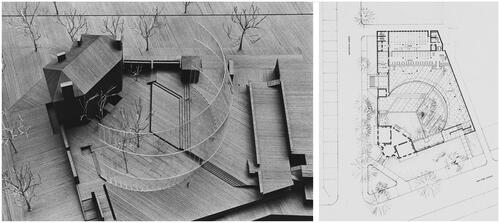
The project posed an urban ensemble in which the largest built element, with the most contemporary architectural expression, was not conceived as an isolated entity. Instead, the dominant geometry for this new building was delineated by a gently sloping glass wall, roughly semicircular in plan, and at the apex of the curve, also slightly concave in section. Brick façades parallel to the streets incorporated such elements as remnant brick walls and the brick smokehouse on 18th Street; these brick components marked the ends of the glazed arc in plan. The comparatively delicate screen deliberatively framed and foregrounded the garden as an outside room between the Octagon and the new structure. At the time, Washington Post architecture critic Wolf Von Eckardt called the garden “a quiet meeting ground of the old and the new.”Footnote20 More recently Jaimini Mehta has described this strategy as a gesture of “mutual recognition and interdependence between the old and the new.”Footnote21 The incomplete circle of glass facing the Octagon suggested a connection to and fragmentary expansion of the round corner volume that established the centrally located entrance and axis for the historic building—and perhaps the pattern of circles and radial streets of the L’Enfant city. It thus pointed to the significance of the city as found, and actively worked against an outcome in which the larger contemporary addition would dominate the overall scheme.
The AIA competition brief had explicitly called for a project “to achieve the best total architectural result establishing a new and improved relationship between buildings, gardens and the city around.”Footnote22 In the Mitchell/Giurgola proposal, both existing and new elements were suggested as integral to the deliberately inclusive environment. In the resultant city ensemble or “fragment”—which was how Giurgola himself viewed it—the landscaped garden between old and new, and the wider urban context were crucial. Mitchell/Giurgola’s statement which accompanied their competition entry noted: “The Octagon and the new structure are defined in their own terms, their strengths preserved, their independence described, their interdependence designed.”Footnote23 Echoes of the Octagon were registered in the geometry of the plan and section for the additions, and the curvilinear glass skin façade enabled a visual connection from the new built volume to the garden and original Tayloe House. In numerous senses the proposal highlighted the existing historic building. The collective conception framed an image and idea for the evolving American city, in which a building with a deliberately contemporary structure and appearance could be employed to make the older existing parts of the urban environment appear even more valuable and meaningful. In one sense this approach anticipated urban design debates of the following decades; but in another, the project can be read simply as a product of Giurgola’s own views on the relationship between architecture and the city, as articulated in articles he published at this time, most notably his piece in Perspecta in 1965, “Reflections on Buildings and the City: The Realism of the Partial Vision.”Footnote24
Studied attention towards achieving balance and reciprocity between old and new elements in the project was evident, with the space between the existing and proposed buildings a critical consideration, and the garden a clear priority. The architects’ statement highlighted this emphasis: “The definition of the garden, with its levels, art collections and planted areas, the development of the entrances both delineate the planimetric relationship between the Octagon and the headquarters. … [T]he building aspires to be a sequence of environments within a unity of space, the garden, the Octagon, the exhibition gallery, library, the executive offices and the business of the headquarters.”Footnote25
Emphasis on the garden was highlighted, too, in photographs taken of the incomplete competition project model, which showed the proposed curved glazed wall as a freestanding element on a stepped timber base, an image also prefigured in a small perspective design sketch.Footnote26 The photographs prioritised a reading of the project as an extended, constructed landscape, with the Octagon, brick garden walls and retained smokehouse incorporated as existing urban elements. The delicate glazed screen enclosure focused attention on the encircled garden, promoted continuity between this external yet central space and the new surrounding interiors, and framed the Octagon as the most significant built object in the urban ensemble. Continuity between the garden and the surrounding contemporary interiors was developed in the design with paving patterns on the ground floor plan that continued from inside to out. Likewise, perspective drawings framed the proposed building less as a discrete new object and more an inhabited edge to the collective civic situation, a verandah-like loggia that directed attention to the Octagon, garden, and wider city ().
Figure 5. Mitchell/Giurgola Architects, AIA Headquarters, Washington, DC, competition project, Submitted Entry Panel #8. Perspective drawing looking from the proposed new gallery and library, towards the garden and Octagon. Source: Mitchell/Giurgola Collections, The Architectural Archives, University of Pennsylvania (collection 267).

In early design sketches, the geometry of the circular glass wall appears to have been developed in close relationship with the historic buildings. The axis for the Octagon in plan served as a primary axis for the new additions. It formed a new centreline for the proposed glazed symmetrical arc. Further, Mitchell/Giurgola were the only architects from the seven finalists to retain the 165-year-old smokehouse on the site and that structure marked one end of the glass curve. At the other end of the curve, orthogonal brick elements aligned with New York Avenue mirrored the smokehouse plan position. Along both major streets, spatial volumes that contained entrances to the new headquarters echoed the size and geometry of the rectangular rooms in the Octagon plan. The spatial hierarchy and geometry in the plan of the AIA extensions thus reiterated those of the Octagon, where orthogonal rooms aligned with angled street boundaries were disposed either side of a ceremonial circular space. The Octagon can be seen thus as generative for many of the ideas embedded in the planned new building.
An extensive series of design development sketches reflect Giurgola’s diligent efforts to adjust the proposed height and mass of the new building on 18th Street to achieve a complementary relationship between the new and the old, even when the existing structure was very small, as was the case with the smokehouse (). Remarkable attention was paid to creating a new setting for this older fragment, in which the existing minor element was not diminished by the larger height and bulk of the contemporary additions. In each sketch, the smokehouse was afforded an important symbolic role in the ensemble. Located on the southern side of an external niche, the dimensions and form of the retained small brick building were registered within the proposed new structure. In the winning design, entry to the complex from 18th Street was through the space between old and new urban elements ().
Figure 6. Mitchell/Giurgola Architects, AIA Headquarters Competition, Washington, DC. Design sketches for new building volumes studied in relationship to the retained historic brick smokehouse on 18th Street. Source: Mitchell/Giurgola Collections, The Architectural Archives, University of Pennsylvania (collection 015).
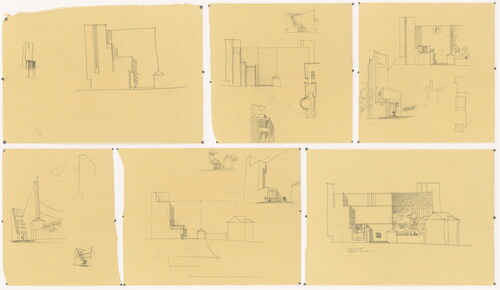
Figure 7. Mitchell/Giurgola Architects, AIA Headquarters, Washington, DC. Perspective Sketch along 18th Street showing the winning competition entry. Old, new, landscape, city and street elements were collectively framed in an urban ensemble or “fragment.” Source: Mitchell/Giurgola Collections, The Architectural Archives, University of Pennsylvania (collection 015).
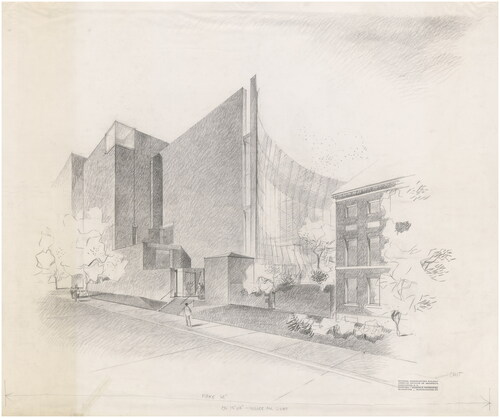
Ada Louise Huxtable, architecture critic for the New York Times, praised the winning Mitchell/Giurgola proposal as “a design of notable subtleties and marked creativity. It exhibited a particular sensibility … a way of making the present serve the past with elegant bravura that compromises neither and enriches both.”Footnote27 The design seemed to defy the emergent post-war logic, implicitly endorsed in the 1964 Venice Charter, that old and new buildings are best kept apart. It suggested instead that the old and new buildings could together constitute a new public figure and re-establish an evolutionary idea of urban form.
The AIA Project
While there were some rumblings of discontent among conservative preservationists in Washington and from the Department of the Interior, and a few critics, such as Wolf von Eckardt, flip-flopped on the merits of the project, the critical reception for the proposal was overwhelmingly positive.Footnote28 The AIA successfully submitted Mitchell/Giurgola’s winning design to the Board of Zoning Adjustment for approval to add the financially required rental space and to waive a technical zoning regulation for a building in that location to have a nineteen-foot, ten-inch (six-metre) rear yard. Approval was granted in May 1965. Yet before the project was submitted to the Commission of Fine Arts for further approval later that year, the AIA, citing financial reasons, sought a feasibility study from Mitchell/Giurgola for a bigger building located on a larger site. By acquiring the adjacent Lemon Building to the east on New York Avenue, the original site behind the Octagon was enlarged, adding more rental space so as to better support the cost of construction. The maximum built square footage for the combined sites was 161,500 square feet (15,000 square metres), which the architects advised against; the initial equity investment was too large, and the AIA would be overburdened with rental space. At the same time, the smallest reasonable version, 110,000 square feet (10,200 square metres), would not provide enough income-producing space to offset the investment cost, and the “underdevelopment” of such a site would not be attractive to lending institutions. Mitchell/Giurgola suggested a compromise of 130,000 square feet (12,100 square metres). The AIA also indicated that the larger site would allow greater distance between the Octagon and the new building, alleviating the impact of the latter. It was tacit acknowledgement at this stage that the new and the old would have to be kept apart rather than be complementary and this crucial juncture in the process was to undermine the set of spatial conditions and financial assumptions that underpinned the initial Mitchell/Giurgola project.Footnote29
To accommodate the proposed enlargement of 59,000 square feet (5,500 square metres) from the original 71,000 requested in the competition brief, and a project more than fifty per cent bigger than the winning competition proposal of 84,000 square feet, Mitchell/Giurgola developed at least two additional designs. In 1967, Scheme II was finally approved by the AIA Headquarters Committee and won enthusiastic support from critics and attendees at the June 1967 AIA convention.Footnote30 Also ninety feet high, it was a brick-faced, reinforced concrete structure in the form of a large, broadly symmetrical V-shaped plan at the lower levels, with the apex located furthest from the Octagon, on axis with it at ground level. At the highest level, the new building formed a large concrete proscenium arch perpendicular to that axis (). Parallel to the rear façade of the Octagon, facing the new building, this large portal in turn framed the older structure. Five office floors of the seven-storey building stepped successively out over the garden as an angled glass façade. In section those upper levels sloped towards the Octagon and the rear portion of the new building sloped back accordingly towards street boundaries at the north-eastern site corner. This geometry allowed for skylights that introduced natural light into each of the stepped floors of offices ().
Figure 8. Mitchell/Giurgola Architects, AIA Headquarters, Washington, DC. Perspective sketch from 18th Street showing Scheme II (1967), donated by Giurgola to the Avery Library in 1980. Source: Romaldo Giurgola drawings, 1965–77, Avery Architectural & Fine Arts Library, Columbia University, New York.
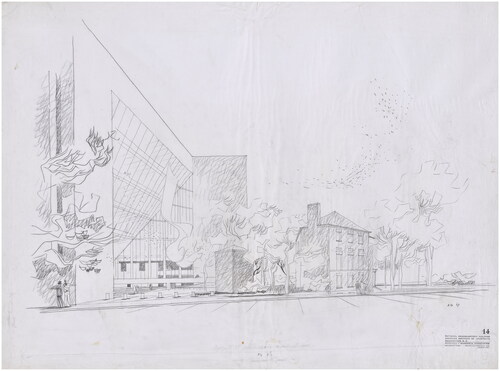
Figure 9. Mitchell/Giurgola Architects, AIA Headquarters, Washington DC. Perspective sketch from New York Avenue showing a revised larger 90–feet high Scheme II, dated May 1967. Source: Mitchell/Giurgola Collections, The Architectural Archives, University of Pennsylvania (collection 267).
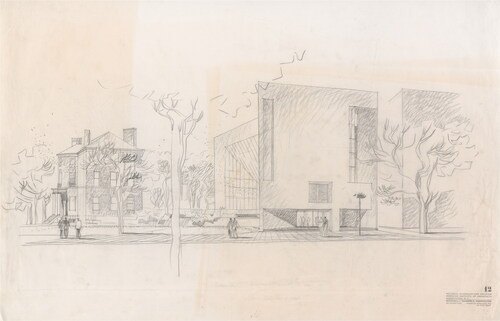
In Mitchell/Giurgola’s revised Scheme II, the scale of the proposal created a stronger, more vigorous contrast between the Octagon and the contemporary additions. The uppermost horizontal frame was far closer to the older building and the dramatically angled geometry of the new structure also overlooked the garden in a more imposing manner than had its previous iteration. Though posing a more dynamic confrontation between the old and new urban elements, strategic continuities also linked this project to the competition winning design. Such concerns can be traced by comparing the comprehensive drawing set held in the University of Pennsylvania Architectural Archives with seven drawings of the project Giurgola later, in 1980, submitted to the Avery Library at Columbia University as a minimal record of the entire design process.Footnote31 All three of the pencil drawings depicting Scheme II given to Avery were perspectives: a view of the urban ensemble from 18th Street; an interior perspective looking from the new building towards the Octagon and smokehouse; and a perspective of the new ground floor interior. Exterior perspective views in both collections emphasised the significance of the Octagon, smokehouse, and garden. In the perspective from 18th Street, those retained elements formed a central focus in the drawing and the larger new addition was framed as an edge to the inhabited landscape and urban ensemble.Footnote32
When the AIA presented Mitchell/Giurgola’s revised scheme to the CFA in 1967, it was rejected. The decision was unexpected. It was the first scheme to come before the Commission and had been strongly supported at the AIA convention. Minutes of the Commission’s January meeting summarised its position as follows: “there was a general feeling that the proposed design relied too heavily on some of the popular current stylistic idioms suggestive of Boston City Hall or other similar manneristic approaches to architecture.”Footnote33 Gordon Bunshaft, acting as the committee spokesman, asserted that “the design is out of scale with the Octagon House and its garden, and inappropriate for the site.”Footnote34
In February 1968, Mitchell/Giurgola returned to the Commission with a radically revised Scheme III (). To address the concerns raised by the CFA, square footage had been reduced and the height of the building, again with a V-shaped plan, had been lowered to 72 feet (21 metres). The extent to which the new building overlooked the Octagon was mitigated, and the angled volume and substantial glass façade were removed. More conventional vertical walls framed a perceived increased extent to the garden, separated by an angled glass lightwell or “notch” positioned on the same axis in plan as the Octagon.
Figure 10. Mitchell/Giurgola Architects, AIA Headquarters, Washington, DC. Elevation on New York Avenue showing a further revised 70–feet high Scheme III, dated June 22, 1968. Source: Mitchell/Giurgola Collections, The Architectural Archives, University of Pennsylvania (collection 267).
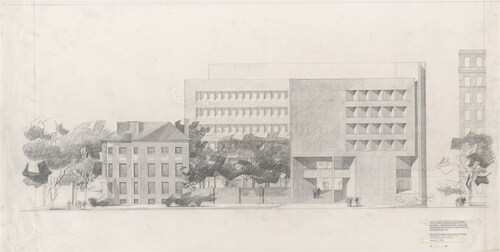
As a record of the 1967–68 Scheme III, Giurgola’s gift to the Avery Library included two pencil drawings of this design, an exterior perspective and a measured partial elevation. The street perspective framed a more distant view than perspective depictions of the previous projects and embraced a wider portion of the urban scene (). The view was framed from the larger New York Avenue rather than the narrower 18th Street, and trees were emphasised: in the foreground, streetscape, around the Octagon, and within the retained garden between old and new buildings. Giurgola’s perspective on the project and its development, whether justified or not, was consistent in asserting the idea that the new headquarters was not just an opportunity for the new building to engage with the old but was also inevitably only a fragment of, and a small contribution to, a larger whole: the city itself. Equally, however, the CFA and Bunshaft’s preference for a new, clearly modernist, but respectful background building rather than a compositionally engaged one is evident by the time the third scheme was assessed.Footnote35
Figure 11. Mitchell/Giurgola Architects, AIA Headquarters, Washington, DC. Perspective sketch from New York Avenue showing Scheme III (1968), donated by Giurgola to the Avery Library in 1980. Source: Romaldo Giurgola drawings, 1965–77, Avery Architectural & Fine Arts Library, Columbia University.
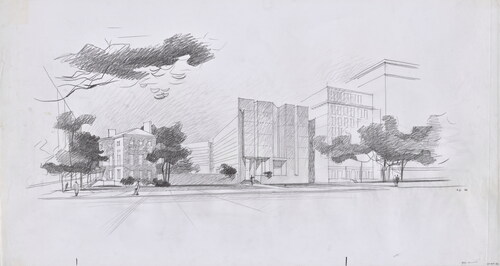
The CFA concluded that the proposed changes in location, massing and height had mitigated the problematic relationship with the Octagon, but the members felt the “facade continued to have an unresolved combination of current cliches.”Footnote36 At a meeting in April 1968, Giurgola showed new sketches with changes in fenestration, on which Bunshaft commented: “We approve the mass, materials, sense of order, facade on the street, but are not participating in approval of the exterior facade of the court, which is an AIA decision.” And: “I think the AIA deserves this. I think it is a goulash. I think it is not architecture at all and it will be a freak of 1967, … I don’t think you’re going to make Giurgola do a building that the FAC would agree is a fine building."Footnote37 When a model version of this design was presented in June 1968, Bunshaft again rejected the design, noting he would not “be a party to that corner.”Footnote38
Architectural Aspirations and Real Estate Logic
One could be forgiven for concluding that the objectives of the AIA competition brief and the winning design that it elicited were undermined by the design review process; and that, as some accounts from the period imply, professional rivalry between the established man, Bunshaft, and the younger architect academic, Giurgola, was the source of the problem that sank the latter’s scheme. But it is worth remembering that Bunshaft and the CFA were never asked to review the original proposal. They rejected as inappropriate two designs developed only after the competition winner had been selected and that were quite different in character from the initial project. We are left, therefore, with a dearth of evidence about the official view from the Commission on Mitchell/Giurgola’s original competition-winning design. Recent scholarship on Bunshaft has remarked on his clear animus towards Giurgola and his “Philadelphia School” contemporary Robert Venturi, who was involved in a more public conflict with Bunshaft about a different Washington project in 1968.Footnote39 Bunshaft’s repeated use of mannerist and mannerism as terms of abuse was carefully calibrated to distinguish his own modernism from the work of these younger, more academically oriented architects. But given the substantive basis for the CFA’s rejection of the second scheme, it remains an open question whether the original Mitchell/Giurgola design might have won their approval without significant controversy. A range of professional and critical opinion from the period indicates almost universal acclaim for that competition entry and one of the CFA’s own members, John Carl Warnecke, was involved in its selection.
These circumstances imply that a significant part of the problem might lie beyond a difference of opinion about the direction of contemporary architecture in 1967 or differences of outlook between Giurgola and Bunshaft. The explanation for the failure to construct the competition-winning design lies just as much in a conflict that is structural rather than personal or stylistic. In the end the AIA was unable to achieve its aspirations. These objectives were not obviously inconsistent, but the attempt to achieve them all proved elusive. There were arguably four distinct aspirations underlying the project to create a new headquarters: (1) good stewardship of a significant historic building with which the AIA had a longstanding connection; (2) adding a contemporary building of significant architectural merit that engaged carefully with the value of the existing building and the qualities of the site; (3) retaining a high-value location in the national capital close to both the White House and the GSA; and (4) a need to maintain and expand the Institute’s status as a credible and capable voice for the architecture profession.
The Tayloe House was, in the period, regarded by the AIA as a great asset. Designed by William Thornton, the first architect of the US Capitol, it was one of the oldest houses in the District. It was home to President James Madison and his wife Dolley for six months while the White House was rebuilt following its sacking by British troops in 1814 and was, briefly at least, a central place in the affairs of state. The man who built the Octagon and spent his winters there between 1802 and 1817 was the Virginia planter and businessman John Tayloe III. One of the wealthiest men in the United States, and a significant figure in the early republic, his wealth, like that of other wealthy Virginians at the time, was built on slavery. This legacy is today at the forefront of the way the AIA interprets the site and were they faced now with the set of choices they confronted in the early 1960s, it seems conceivable that they would arrive at a different decision about the property. But they did not then spend any institutional time or energy considering Tayloe as a person or the idea that the place was built on the proceeds of slavery and by the hands of enslaved people. The Octagon’s connection to slavery went largely unmentioned in architectural guidebooks and local histories and the AIA’s lack of concern with this aspect of its past would have then seemed unremarkable. Instead, the Octagon was a source of pride, an unambiguous institutional asset that made the AIA a kind of trusted cultural patron.Footnote40 In the period it was regularly referred to as the third most historically significant building in the city and appeared automatically on all the early inventories of historic places in Washington.Footnote41 But the AIA’s role as a steward of this significant property came with a set of obligations to protect and conserve the building. With that cultural capital came financial costs.
Despite the growing prominence of historic preservation nationally in this period, and the assumption of architectural leadership in matters of preservation, it was still not core business for the AIA. The design of new buildings remained the principal function of the architecture profession. As such, when the AIA set out to create a new home for themselves, they were widely expected to create an exemplary work of architecture and certainly to do more than minimise the impact on the established cultural value of the Octagon. Hence the determined intent in the AIA competition brief to develop “a building of special architectural significance, establishing a symbol of the creative genius of our time.”Footnote42 This was to happen not simply alongside a preserved Octagon, but in a manner that explicitly complemented the existing building. It was a challenging brief, but a challenge that Mitchell/Giurgola had successfully addressed in the eyes of the jurors and the 1965 AIA conference delegates.
Preserving the Octagon and designing an accompanying building implied that the AIA remain in its longstanding, prestigious and strategically useful location. Not only was it a near neighbour to the White House, it was directly across the street from the GSA buildings, the centre of government activity most relevant to the AIA. Despite some internal pressure to consider alternatives, the arguments for retaining their established location were substantial. The hitch was that they could not really afford a new building. To raise the required finance for the development, the Institute authorised the mortgaging of the site at its 1963 conference.Footnote43
The alternative to indebtedness was to forgo their planned expansion. But given the growing economy, and the sense of opportunity that economic growth provided for the architecture profession as a whole, that hardly seemed advisable. The set of obligations felt by the Institute towards both its headquarters and its members all pointed towards expansion, meaningful preservation, and an exemplary new work of architecture. But the need to mortgage their property implied entry into the logic of commercial real estate. The competition brief had initially asked entrants to make provision for one quarter of its floor area to be made available to let as office space to offset amortisation costs. No matter how sincere the organisation was in its pursuit of meaningful preservation and exemplary architecture, once the calculation was made about rental income, mortgage feasibility and financing, the wider urbanistic pressures were inevitably part of the process. The decision to expand the project to 130,000 square feet and acquire a neighbouring building was simply the extension of such a real estate logic. Whether or not the AIA had meaningful options, the priorities of property undermined the architectural aspiration at the heart of the competition brief and greatly compromised Giurgola’s position.
The Final Outcome
After Mitchell/Giurgola resigned from the project in September 1968 the AIA Board of Directors established a new Headquarters Committee, inviting Romaldo Giurgola to join, together with the 1964 competition runners-up: Philip Will Jr. of Perkins & Will, and I.M. Pei. They recommended a shortlist of architects to interview: Edward Larrabee Barnes, who had served on the original competition jury, Gunnar Birkerts, Marcel Breuer, Ulrich Franzen, Keyes Lethbridge and Condon, The Architects’ Collaborative (TAC), Mies van der Rohe (who refused), and Harry Weese. TAC was selected as the result of a weighted ballot and in November 1969 also faced the Commission of Fine Arts. Designed by Norman C. Fletcher and Howard F. Elkus within Walter Gropius’ Collaborative, TAC’s project finally met with approval by the CFA, though as Suzanne Stephens noted in her account of the project, “it too had to go through several revisions before all elements of ‘overblown mannerism’ were ironed out.”Footnote44
The project by TAC approved by the CFA () was both taller and larger than the final Mitchell/Giurgola scheme. Bent in a V-shaped plan, a façade of repetitive horizontal beams included repeated ribbons of glazing between the floor and concrete spandrels in a continuous line from 18th Street to New York Avenue. This unified expressive device contrasted strongly with Giurgola’s proposed Scheme III, which had divided the new AIA headquarters behind the Octagon into two roughly symmetrical wings. These could read almost as two buildings, each with a major façade to the adjacent street and a vertical face divided into horizontal concrete bands that formed a wall to the garden.
Figure 12. TAC Architects, Norman Fletcher and Howard Elkus. Model for AIA Headquarters, Washington DC, approved by the Fine Arts Commission in 1970. The approved, finally realised project was both taller and larger than the Mitchell/Giurgola Scheme III. Source: AIA Archives.
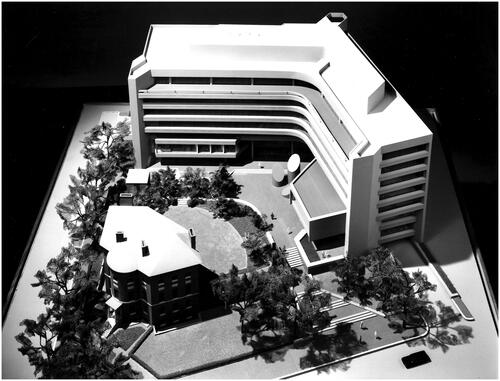
The approved project presented a horizontally disposed, concrete-framed background to the more vertically oriented and smaller brick Octagon. Separated by a new landscaped terrace which served as a memory of the former garden and extended paved forecourt to the new headquarters, the building designed by TAC posed a deliberate contrast and robust challenge to the scale and material assembly of the more delicate historic building. Comparing the three Mitchell/Giurgola schemes (recalling ) with that of TAC, one can further read a strategic contrast in the design of the outside space; in all Giurgola’s drawings and designs, the garden is treated as an external “room” or spatial participant in the urban ensemble. This differs from the sense of an outside paved plateau around the realised building, one on which both the Octagon and new headquarters stood as differently shaped objects.
As the outcome of expert talent from within the AIA and informed by its own recommended external panel review process, the built results were seen as less than impressive. One critic quipped: “The AIA promised a memorable feast and served a frozen dinner.”Footnote45 In the New York Times, Ada Louise Huxtable likewise captured the profession’s significant disappointment:
It isn’t that the new structure is not a reasonably good building. If the AIA was looking for symbols, or standards, however, it has come up only with what might be described as high-level average. It seems to function pleasantly and it would be adequate enough any place but here.… But this is not the point. The point is that the AIA set itself the conscious and sensitive task of designing and erecting a building to go with the Octagon. It was to be an object lesson in the blending of new and old in the particular way that Washington needs so desperately and muffs so consistently. After all, who but the architects could, and should, set an example?Footnote46
Huxtable went on to note inconsistencies within the CFA’s advice, identifying that “[the TAC building’s] insistent, dominating horizontal bands of precast concrete destroy rather than preserve scale. The design is brutally insensitive to Thornton’s far more delicate detail. The Octagon has lost presence; it now looks like a toy. The octagon garden, while almost the same size as before in square feet, is unbelievably diminished by too much paving and too few trees and the heavy-handed, looming presence behind.”Footnote47 These precise problems—apparent domination of the new over the old; too great a difference between the built qualities of the existing and contemporary actors on the urban scene; and constructed insensitivity in the relationship between the Octagon and new additions—were the stated reasons Mitchell/Giurgola’s second and third schemes design failed to satisfy the CFA. This anomaly can only be explained by Gordon Bunshaft’s apparent unwillingness to engage in the work of the Commission in good faith. As Adams has noted, Bunshaft “strayed from the commission’s remit” in his questioning of Giurgola’s design.Footnote48 The CFA minutes also reveal a persistent hostility to Giurgola’s overall approach to architecture, which was self-consciously inclusive.
Conclusion
When the AIA regretfully announced Mitchell/Giurgola’s resignation and withdrawal from the project, a parallel announcement updated progress made towards restoration of the Octagon and the financial means through which this would be realised. The resolution was to keep new and old apart. Preservation would be supported but divorced from the project to design an exemplary new building for the profession. For his part, Giurgola deplored the idea that each needed to be clearly separate and the old building isolated as a monument. For him it was an architectural retreat from the very idea of a city, which implied a continuous evolutionary process and thus the necessity of different formal and spatial orders intersecting and overlapping. At the Commission of Fine Arts meeting in September 1967, he asserted: “we endorsed since the beginning the attitude of making a building which included the old … not separated. I think a great deal of harm … is given by the fact you are thinking always of one building beside the other building, finished in themselves.”Footnote49
One is tempted to imagine what might have been possible if the AIA had access to enough capital to realise the competition-winning entry. Given the strong professional agreement around the merits of the early Mitchell/Giurgola scheme, it is conceivable that the clear ideological differences with Bunshaft might not have been brought into such stark relief. But the AIA had neither the unanimity of purpose nor the financial capital necessary to implement such an ambition. Consequently, the process also registered the specific extent to which architects and architecture lacked the agency to reconcile such forces; at least to reconcile them with the radical ambition exhibited in Giurgola’s competition winning design. It was more the logic of the organisation representative of architectural professionals, than exemplary architectural design that prevailed. In the end, for a professional body, the architecture was representative.
Acknowledgements
The authors would like to thank Bill Whitaker at the University of Pennsylvania Architectural Archives, staff at the Avery Library at Columbia University and Nancy Hadley at the American Institute of Architects (AIA) Archives. We also want to acknowledge Jessica Kroese at the University of Sydney for her assistance with research and the preparation of the article.
Disclosure Statement
No potential conflict of interest was reported by the author(s).
Additional information
Funding
Notes on contributors
Catherine Lassen
Catherine Lassen is an architect and senior lecturer in architecture in the School of Architecture, Design and Planning at the University of Sydney. Her work on late modern architecture in Australia includes books, chapters, papers, and curated exhibitions focused via architectural drawings on architects such as Hugh Buhrich (1911–2004) and Glenn Murcutt. A chapter in Companions to the History of Architecture: Volume IV Twentieth-Century Architecture (Wiley 2017) framed Murcutt’s work through a close reading of his Marie Short House.
Cameron Logan
Cameron Logan is an urban and architectural historian and director of the postgraduate program in heritage conservation in the School of Architecture, Design and Planning at the University of Sydney. His work is concerned with the historicity of the built environment and the civic and cultural claims connected with architectural and urban conservation. He is the author of Historic Capital, Preservation, Race and Real Estate in Washington, DC (2017) and co-editor of Adapt: New Lives for Old Buildings (2024).
Notes
1 American Institute of Architects (AIA), Program of Competition for a National Headquarters Building for the American Institute of Architects (Washington, DC: AIA, 1964), 15.
2 “AIA Headquarters Building Competition,” American Institute of Architects Journal (hereafter AIA Journal) (January 1965): 23
3 New Headquarters Building Announcement, AIA Press Releases, 015.IV.005, Mitchell/Giurgola Architects Collection, Architectural Archives, University of Pennsylvania.
4 Cameron Logan, Historic Capital: Preservation, Race and Real Estate in Washington, DC (Minneapolis: University of Minnesota Press, 2017), 132–38; John H. Sprinkle Jr, Heritage Conservation in the United States: Enhancing the Presence of the Past (London: Routledge, 2022).
5 Mitchell/Giurgola Architects Collection, Architectural Archives, University of Pennsylvania.
6 Jaimini Mehta, Critiquing the Modern in Architecture (New York: Routledge, 2017), 130–36; Nicholas Adams, Gordon Bunshaft and SOM: Building Corporate Modernism (New Haven, CT: Yale University Press, 2019), 193–98.
7 The Australian phase of Giurgola’s career (1978–2006) has been documented in Stephen Schrapel, “Romaldo Giurgola in Australia and the other Modern Tradition” (PhD diss., University of Adelaide, 2015). But in the period from the early 1950s to the late 1970s, which Giurgola spent in the United States, his career has attracted scant historical attention, despite the architect’s prominence in the period. The only real exceptions are the Mehta book and a recent collective biography of the Philadelphia School: John Lobell, The Philadelphia School and the Future of Architecture (New York: Routledge, 2023).
8 On the literature on adaptive reuse, see Francesca Lanz & John Pendlebury, “Adaptive Reuse: A Critical Review,” Journal of Architecture 27, nos 2–3 (2022): 441–62. On the new into old literature, see Nathaniel Rogers, “Literature Review,” Change Over Time 2, no. 2 (2012): 202–18; and the special issue Pamela Hawkes, ed., “Design + Heritage,” Change Over Time 7, no. 2 (2017). On Giovanonni see Simona Benedetti, Roberta Maria Dal Mas, Ilaria Delsere, and Fabrizio Di Marco, Gustavo Giovannoni: L’opera architettonica nella prima meta del Novecento (Rome: Campisano, 2017).
9 Daniel Patrick Moynihan, Guiding Principles for Federal Architecture (Washington, DC: General Services Administration, 1962), http://www.gsa.gov/portal/content/136543.
10 Francis Lethbridge, “Goals of the Landmarks Committee,” Records of the Columbia Historical Society (October 1964): 448–51; John H. Sprinkle, Jr. “Preservation was Never Static,” in Giving Preservation a History: Histories of Historic Preservation in the United States, ed. Max Page and Randall Mason (New York: Routledge, 2019), 369–88.
11 The most important statement of international preservation doctrine in the period was the Venice Charter. The Second International Congress of Architects and Technicians of Historic Monuments, “International Charter for the Conservation of Monuments and Sites” (Venice Charter) (Venice, 1964), adopted by ICOMOS 1965, https://www.icomos.org/en/participer/179-articles-en-francais/ressources/charters-and-standards/157-thevenice-charter.
12 Lois Craig and the staff of the Federal Architecture Project, The Federal Presence: Architecture, Politics, and Symbols in United States Government Building (Cambridge, MA: MIT Press, 1978), 309–37; Kurt Helfrich, “Modernism for Washington? The Kennedys and the Redesign of Lafayette Square,” Washington History 8, no. 1 (1996): 16–37.
13 “The Square is Spared,” Washington Post, October 1, 1962; Frederic Gutheim and Antionette J. Lee, Worthy of the Nation: From L’Enfant to the National Capital Planning Commission, 2nd ed. (Baltimore, MD: Johns Hopkins University Press, 2006), 303–305; Helfrich, “Modernism for Washington,” 16–37.
14 AIA, Program of Competition, 15.
15 Logan, Historic Capital, 135–36.
16 Joseph R. Passonneau, Washington Through Two Centuries: A History in Maps and Images (New York: Monacelli Press, 2004), 106–205.
17 AIA, Program of Competition, 15.
18 “AIA Headquarters Building Competition,” AIA Journal, 26
19 The existing floor area ratio of 5.5 allowed for 99,700 square feet.—Suzanne Stephens, “Magnificent Intentions,” Architectural Forum 140, no. 3 (October 1973): 38.
20 Wolf Von Eckardt, “Octagon House to Get New Setting,” Washington Post, December 20, 1964, A29.
21 Mehta, Critiquing the Modern, 130.
22 AIA, Program of Competition, 15.
23 “AIA Headquarters Building Competition,” 26.
24 Romaldo Giurgola, “Reflections on Buildings and the City: The Realism of the Partial Vision,” Perspecta 9–10 (1965): 107–30.
25 “AIA Headquarters Building Competition,” 26.
26 Both sketch and photograph of the model are held in Mitchell/Giurgola Architects Collection, Architectural Archives, University of Pennsylvania.
27 Ada Louise Huxtable, “The Architects Design their ‘Dream’ Home,” New York Times, July 12, 1970, 88.
28 “Architects’ Institute May Reject Winning Design for Headquarters,” Washington Post, November 9, 1965, B2.
29 Stephens, “Magnificent Intentions,” 39.
30 “A.I.A. National Headquarters Building By TAC,” Architectural Record, August 1970, 44.
31 Giurgola Collection, folders 3–5, Drawings & Archives, Avery Fine Arts Library, Columbia University, New York.
32 Giurgola Collection, Avery Fine Arts Library.
33 Minutes of the meeting of the Commission of Fine Arts, January 25, 1967, https://archive.org/details/cfaminutes25jan1967.
34 Stephens, “Magnificent Intentions,” 40.
35 Giurgola Collection, Avery Fine Arts Library.
36 Stephens, “Magnificent Intentions,” 40.
37 Stephens, “Magnificent Intentions,” 40–41.
38 Stephens, “Magnificent Intentions,” 41.
39 Adams, Gordon Bunshaft and SOM, 195–98
40 George McCue, Octagon: Being an Account of a Famous Washington Residence: its Great Years, its Decline and its Restoration (Washington, DC: American Institute of Architects Foundation, 1976), 25–48.
41 Joint Committee on Landmarks, “Landmarks of the National Capital Preliminary List: Report to the National Capital Planning Commission and the Commission of fine Arts by the Joint Committee on Landmarks,” November 1964, Commission of Fine Arts Records and Research.
42 AIA, Program of Competition, 15.
43 Stephens, “Magnificent Intentions,” 39.
44 Stephens, “Magnificent Intentions,” 41.
45 American Institute of Architects, “The History of the AIA National Headquarters” (2021), https://content.aia.org/sites/default/files/2021-07/The_history_of_AIA_national_headquarters.pdf, Accessed 10th July, 2023.
46 Ada Louise Huxtable, “Of Capital Failure and Capital Crimes,” New York Times, March 17, 1974, 139.
47 Huxtable, “Of Capital Failure,” 139.
48 Adams, Gordon Bunshaft and SOM, 195.
49 Minutes of the meeting of the Commission of Fine Arts, September 19, 1967. https://archive.org/details/cfaminutes19sept1967/page/n273/mode/2up?view=theater.
